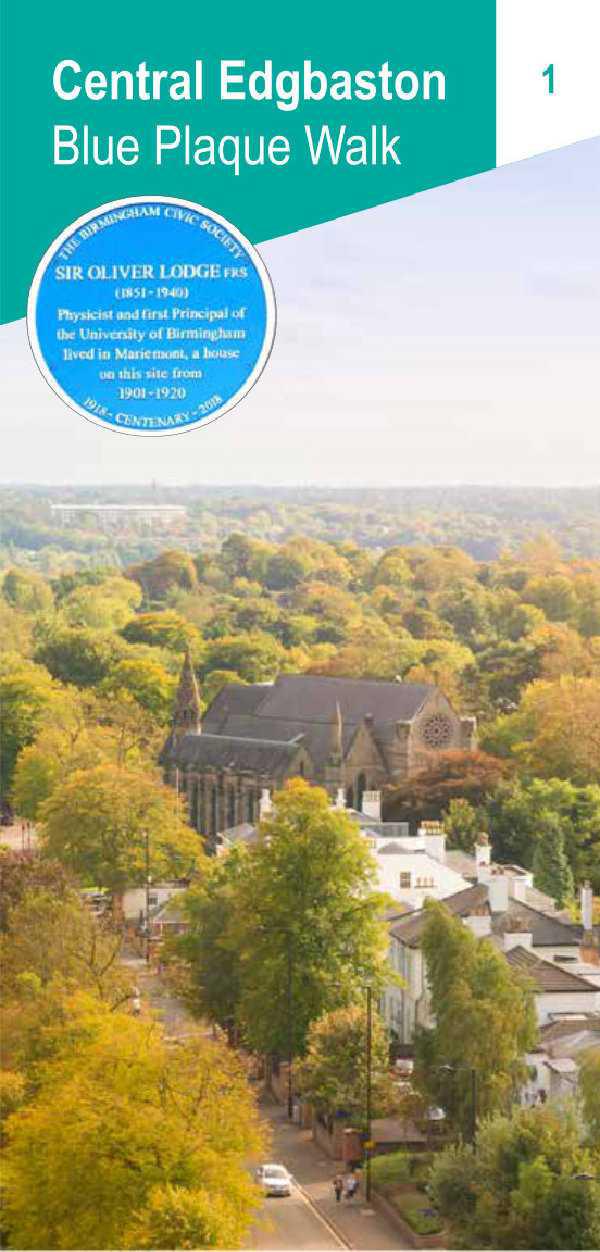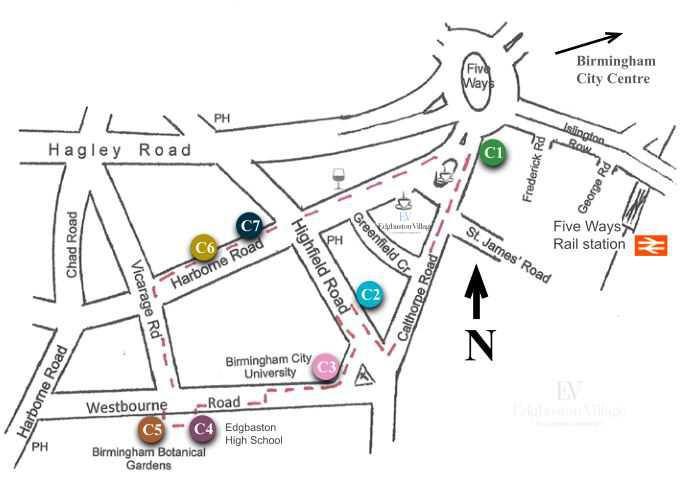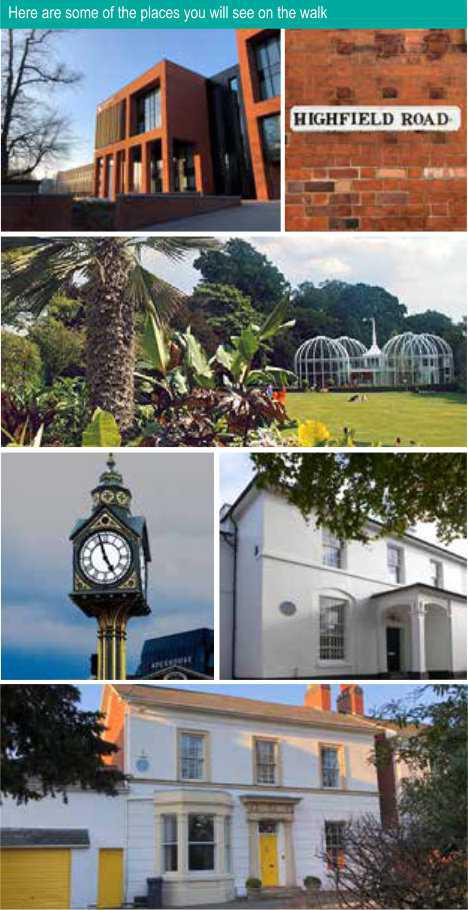Walking distance 1.6 miles / 2.57km
Category Easy
Places to eat, drink and relax in Edgbaston: www.edgbastonvillage.co.uk
For a Brief history of Edgbaston click here.
The walk begins on Calthorpe Road just off the Five Ways roundabout. As you walk around look for the blue plaques at the locations indicated on the sketch map at the bottom of this page.
From Calthorpe Road walk south, away from the Five Ways roundabout to find plaque C1 on the HSBC building to the left.
C1 WASHINGTON IRVING (1783-1859) - 12 Calthorpe Road
Washington Irving was an American essayist, historian and diplomat, serving as the American Ambassador to Spain 1842-1846. Born in New York city, he suffered from ill-health off and on for many years. In 1804 Irving set sail from New York Harbour bound for a spa in Bordeaux, France, to treat a lung ailment. For the next two years he travelled throughout Europe including Britain. He enjoyed the hospitality of sophisticated European society and indulged his love of art, theatre and opera. However, his Grand Tour ended when, in 1806 and restored health, he returned to America and was called to the bar. In 1815 he left America for England to visit his brother and remained for the next seventeen years, again travelling to various countries in Europe. While in England, an unsuccessful business venture caused him to turn to his pen in hopes of providing some income. Irving’s short stories, including ‘Rip Van Winkle’ and ‘The Legend of Sleepy Hollow’ first printed in America under his pseudonym Geoffrey Crayon between the years 1819-20 were collected in ‘The Crayon Papers’ and ‘The Sketch Book of Geoffrey Crayon’. He died in America on 28th November 1859, and is buried in Sleepy Hollow Cemetery, New York.
Continue along Calthorpe Road to St. George’s School and cross at the lights into Highfield Road. Number 26 is about half-way up on the right.
C2 EDWARD TAYLOR (1838-1911 ) & WILLIAM TAYLOR (1876-1935 ) - 26 Highfield Road
An artist and educator, Edward Taylor was born in Hanley, Stoke-on-Trent. He trained at Burslem School of Art and was influential in the Arts and Crafts movement. He became the first headmaster of Birmingham School of Arts and Crafts and went on to found the Ruskin Pottery at Smethwick. This was primarily known for its innovative use of glazes but they also made small round cabochons called ‘enamels’ or ‘plaques’ intended to be inserted into wood or mounted on metal. On his death, his son William took over the firm, but the secret of the glazes died with him in 1935.
Cross Highfield Road and go back the way you came, turning right opposite the church and right again into Westbourne Road. The next plaque is on the side of the first University building on the right, facing the church.
C3 OLIVER LODGE (1851-1940) - Birmingham City University, Westbourne Road
A physicist and writer, Oliver Lodge was involved in the development of radio and demonstrated the existence of electromagnetic waves. Born in Staffordshire, he worked in the family business selling clay to the potteries until he was 22. He then went to the University of London obtaining a doctorate in science before taking up an academic post at Liverpool University. Living in Edgbaston and later Barnt Green, he became the first principal of Birmingham University in 1900, a position he held until 1919. The father of twelve children, he lost a son Raymond in the First World War, which served to increase his interest in spiritualism. Unfortunately, this overshadowed his considerable scientific achievements. Two of his sons successfully used his scientific discoveries in their business of manufacturing spark plugs.
Walk down Westbourne Road to the second set of pedestrian lights and cross. Continue past the main Edgbaston High School and look for the plaque on the Preparatory School.
C4 NEVILLE CHAMBERLAIN (1869-1940) - Edgbaston High School Preparatory School building, Westbourne Road
Born in Edgbaston into a political family (his father was Joseph and older half-brother Austen), Neville Chamberlain will forever be remembered for brokering the Munich Agreement of 1938 in which Sudetenland was ceded to Nazi Germany in return for ‘Peace in our Time’. Following the outbreak of hostilities in 1939, he was vilified for his policy of appeasement, but many today argue that he gained valuable time for Britain’s preparations for an inevitable war.
Politics was a second career for Chamberlain. He started as a businessman, first disastrously on a sisal plantation in the Bahamas, then successfully managing for 17 years a Birmingham company making metal ships’ berths and hospital beds.
Although long involved in civic activities, it was 1911 before Neville became a city councillor and later Lord Mayor in 1915. At 49 he became Unionist MP for Ladywood, rising rapidly to become Chancellor of the Exchequer and then Prime Minister in 1937. His premiership saw the introduction of legislation to better the lot of working people, including laws restricting working hours, improving factory conditions, introducing paid holidays, rent control and slum clearance. After the disastrous Norway campaign following German invasion in 1940, he resigned as Prime Minister and died six months later of bowel cancer.
Walk through the path to the Botanical Gardens car park and look for the next plaque on the wall to the left of the garden’s main entrance.
C5 ERNEST WILSON (1876 -1930) - Botanical Gardens, Westbourne Road
Ernest Henry ‘Chinese’ Wilson, came to live at Monkspath just outside Birmingham as a small boy. He left school at thirteen and was apprenticed to a plant nursery in Solihull. From sixteen, he was employed as a gardener at the Birmingham Botanical Gardens where he is commemorated by this blue plaque. While at the Gardens he studied at evening classes, winning the Queen’s prize for Botany. At the age of 21 he moved to work at Kew Gardens, later becoming a teacher of botany at the Royal College of Science. He is most famous for his exploration, photography and collecting of exotic plants and seeds in China and later, Japan. He introduced over 2000 plants from the Orient to the west and wrote a number of books illustrated with his own photographs. In 1911 he began working at the Arnold Arboretum in Boston Massachusetts and it was near here in 1930 that he and his Edgbaston born wife were killed in an automobile accident.
Exit the car park onto Westbourne Road and cross at the lights into Vicarage Road. Walk to Harborne Road and cross before turning right for next two plaques.
C6 FRANCIS BRETT YOUNG (1884-1954) - 105 Harborne Road
Born in Halesowen, the son of a doctor, Francis Brett Young was schooled near Birmingham and in 1895 progressed to Epsom College in Surrey, where he showed early signs of literary promise by editing the Epsomian school magazine and winning the Rosebery Prize for English Literature. He then returned home to read medicine at Birmingham University. He became a GP in Brixham, but his first love was writing and he eventually gave up his medical practice to write novels, plays and poetry. He suffered from ill health and sought warmth, settling in Capri in 1919 with his wife Jessie. Here he began a series of novels with a Midlands setting. His Birmingham-based stories contained vivid descriptions of life in the area during the turn of the century. However, he considered his best achievement to be the long work entitled ‘The Island’, written during the second world war and covering English history from pre-historic times. He and his wife returned to England but further ill-health sent them to warmer climes again, this time to South Africa where he died in 1954. He is buried in Worcester Cathedral.
C7 AUSTEN CHAMBERLAIN (1863-1937) - 83 Harborne Road
Austen Chamberlain was the eldest son of Joseph Chamberlain, and half-brother of Neville Chamberlain. Educated at Rugby and Trinity College, Cambridge, he was first elected as an MP in 1892. A skilled orator, his maiden speech was praised by Prime Minister W.E. Gladstone despite opposing his policy, and he rose quickly to become Chancellor of the Exchequer, a post he held twice in his career. After a number of governmental positions, he became Leader of the Conservative Party in the post WW1 coalition. Loyal to PM Lloyd George he resigned rather than fight the ensuing general election as leader of an independent party. His reputation as a statesman came from his role as Foreign Secretary (1924 -1929), particularly the negotiation of the 1925 Locarno Pact to broker peace between France and Germany. For this he was awarded the Nobel Peace Prize. He died in March 1937, the year Neville became Prime Minister.
By continuing along Harborne Road you will return to the Five Ways.
How to get there
Edgbaston is an elegant leafy suburb just one mile west of Birmingham city centre.
Public Transport
By bus - using Hagley Road towards Quinton or buses to Harborne.
By train - from New Street travel to Five Ways station. For more information visit: www.networkwestmidlands.com
By car - Edgbaston Village is easily accessible by car. Car parking is available at pay and display car parks, and there is limited free on-street car parking.
Walk or Cycle - It is easy to walk and cycle to. Within the Edgbaston Village there are a number of cycle stands.
Walk developed by Heritage Volunteers from The Arts Society Birmingham Evening and sponsored by Calthorpe Residents’ Society and Calthorpe Estates, plus supported by the Local Innovation Fund.







